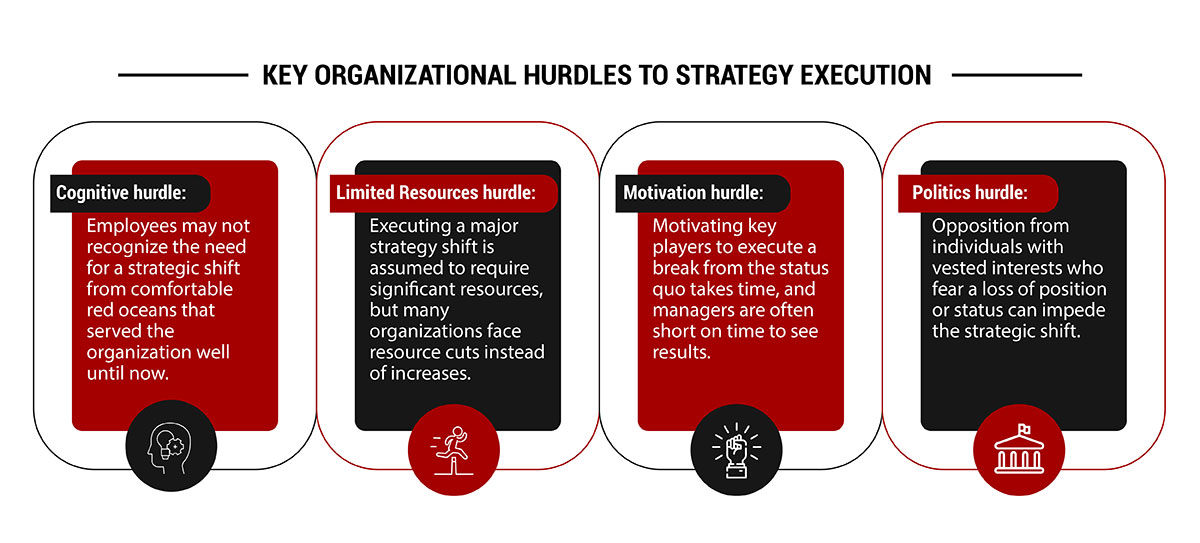Breaking Down the Barriers: A Blueprint for Successful Strategy Execution
Once a company has meticulously designed a blue ocean strategy with a profitable business model, the next crucial phase is its execution. However, implementing any strategy can pose challenges, and organizations often find it difficult to translate ideas into actions, whether in red or blue oceans.
The blue ocean strategy signifies a significant departure from the conventional red ocean strategy. It focuses on a shift from convergence to divergence in value curves while keeping costs low. This increased emphasis on innovation sets a higher standard for successful execution.
Key Challenges in Organizational Strategy Execution
Managers encounter four primary organizational hurdles in strategy execution:
- Cognitive hurdle: Employees may resist the need for a strategic shift from familiar red oceans that have historically served the organization well.
- Limited resources hurdle: Executing a major strategy change is often perceived as requiring substantial resources, yet many organizations face resource constraints instead of expansions.
- Motivation hurdle: Inspiring key stakeholders to embrace a departure from the status quo requires time, and managers are often under pressure to deliver quick results.
- Politics hurdle: Opposition from individuals with vested interests who fear losing their positions can hinder the strategic shift.

While the severity of these hurdles may vary among organizations, overcoming them is crucial to mitigate organizational risks. These obstacles may present significant challenges, but with the right strategies and approaches, they can be successfully navigated.
Let’s delve deeper into each of these barriers and explore potential solutions to overcome them.
Breaking Cognitive Barriers
In the realm of turnarounds and corporate transformations, one of the most daunting tasks is convincing people of the necessity for a strategic shift and reaching a consensus on its underlying causes. CEOs often rely on data presentation and performance improvement to justify the change.
However, data can be manipulated, and unrealistic goals can lead to financial misconduct, breeding distrust within the organization. It’s essential to ensure teams fully understand and align with the need for change before initiating any strategic shift.
Effective Strategies for Driving Change:
- Confronting Operational Challenges Directly: Expose your team to operational issues firsthand to motivate meaningful change.
- Prioritize Customer Feedback: Encourage managers to engage with dissatisfied customers directly to improve business practices.
Overcoming Resource Constraints
Once the need for a strategic shift is acknowledged and the new strategy is outlined, leaders must tackle the reality of limited resources. Instead of fixating on acquiring more resources, focus on maximizing the value of existing resources. Identify hot spots, cold spots, and engage in strategic horse trading to optimize resource allocation.
- Hot spots: Low resource input with high potential performance gains.
- Cold spots: High resource input with low-performance impact.
- Horse trading: Exchanging excess resources within the organization to fill resource gaps effectively.
Overcoming Motivational Barriers
To implement the blue ocean strategy successfully, communication of the strategic shift’s necessity and a plan for execution with limited resources are crucial. Motivating employees to take sustained and meaningful action is essential. Instead of broad change initiatives, concentrate efforts on key influencers, fishbowl management, and atomization to drive change effectively.
Key Influencers and Motivational Strategies:
- Kingpins: Identify and leverage influential individuals within the organization to create a ripple effect.
- Fishbowl Management: Shine a spotlight on key actions transparently to motivate change agents.
- Atomization: Break down strategic challenges into manageable goals for increased success.
Overcoming Political Barriers
Organizational politics can pose a significant threat to strategic changes, even with skilled leadership. Identifying allies, addressing concerns of detractors, and seeking guidance from politically savvy insiders can help navigate political obstacles effectively.
Key Strategies for Managing Organizational Politics:
- Leverage your Angels: Identify and align with individuals who stand to benefit the most from the strategic shift.
- Silence your Devils: Address concerns of detractors to neutralize opposition and build a stronger foundation for success.
- Get a Consigliere on Board: Engage a politically adept insider to guide you through organizational politics and develop success strategies.
In Conclusion…
Executing a successful strategy is a multifaceted process, especially when resources are limited. By overcoming the major barriers and focusing on influential factors, organizations can achieve successful implementation of a blue ocean strategy. Leaders must align actions with the new strategy, avoiding a one-size-fits-all approach to challenges.


